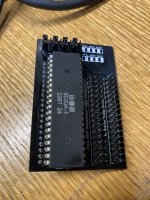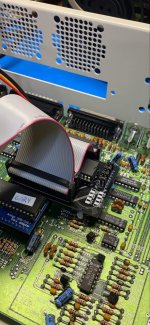grbrady
Experienced Member
I had a spare A500 motherboard that I decided that I'd like to mount in a Checkmate A1500plus case (https://www.checkmate1500plus.com/.) Since it has multiple internal floppy drive bays I thought it would be nice to mount both a Gotek and the original 3.5" floppy drive as internal devices. Unfortunately the A500 internal floppy interface doesn't support this. Others have done this by plugging the second floppy drive into the external connector and the routing the cable back inside the case. This seems inelegant to me, so I decided to try to figure out what circuit is necessary to hook up a second internal floppy to the motherboard. I closely followed the circuit for this on the Amiga 2000 motherboard.
What I've come up with is a schematic for a board that you plug into the even CIA socket (U8.) You also plug in the internal floppy cable to this board. The board routes and generates the required signals and outputs them a second internal floppy connector. You attach a 34 pin ribbon cable with three connectors, with a twist between the two drive connectors, as in the A2000.
I was hoping some of the Amiga experts on here could take a look at the schematic to see if I've done anything clearly wrong. I'm somewhat inexperienced at this and am taking this as an opportunity to learn KiCAD and PCB layout in general.

Thanks,
Greg
What I've come up with is a schematic for a board that you plug into the even CIA socket (U8.) You also plug in the internal floppy cable to this board. The board routes and generates the required signals and outputs them a second internal floppy connector. You attach a 34 pin ribbon cable with three connectors, with a twist between the two drive connectors, as in the A2000.
I was hoping some of the Amiga experts on here could take a look at the schematic to see if I've done anything clearly wrong. I'm somewhat inexperienced at this and am taking this as an opportunity to learn KiCAD and PCB layout in general.

Thanks,
Greg


